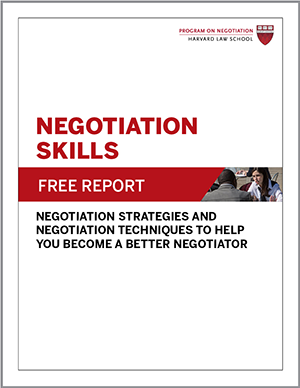What is your greatest source of power in negotiation? You may have learned— perhaps in this newsletter or in Roger Fisher, William Ury, and Bruce Patton’s landmark negotiation book Getting to Yes: Negotiating Agreement Without Giving In (Penguin, 1991)—that it is often a strong BATNA, or best alternative to a negotiated agreement. Experienced negotiators scan the environment before and during a highly anticipated negotiation to determine their backup plan and try to improve it: Job hunters follow other job leads, buyers talk to suppliers’ competitors, and so on.
Your BATNA can be both a useful measure of the quality of a proposal you’re considering and a source of power. When you compare a potential deal to your BATNA, you have a better sense of whether to accept it or push for more. But while BATNA analysis is important, even critical, an overly narrow focus on our BATNA can lead us to make major mistakes in negotiation and leave significant value on the table, according to two recent articles.
In our June issue, we described why negotiators have difficulty assessing uncertain BATNAs accurately and how they can do better. In this article, we stress the value of looking beyond your BATNA to make the most of your interdependence with your current negotiating partner.
Don’t assume you have to walk away
Because the BATNA concept is often defined as an “outside option,” independent of one’s current negotiation, it can be difficult to apply to negotiations conducted between people involved in established partnerships, writes Harvard Business School professor James Sebenius in the April 2017 issue of Negotiation Journal.
“Think of a reasonably content married couple or successful business partners negotiating an issue of keen mutual interest on which they have different preferences,” writes Sebenius. If that married couple can’t agree on where to live after retirement, the only obvious “outside option” would be separation or divorce—hardly an appealing BATNA if they are “reasonably content.” Similarly, when partners in a successful business can’t see eye to eye on a critical issue, they are unlikely to view the dissolution of their partnership as an acceptable BATNA.
When partners in a successful business can’t see eye to eye on a critical issue, they are unlikely to view the dissolution of their partnership as an acceptable BATNA.
Rather than thinking of our BATNA as an “outside option,” Sebenius advises us to think of it more broadly as a “no-deal option.” When we frame our BATNA in this way, exercising our BATNA doesn’t require us to walk away from our current negotiating partner if we’re unsatisfied with their proposal; it just requires us to keep saying no.
Specifically, Sebenius recommends that we consider the full consequences of saying no to the other side and how we might try to influence those consequences to our advantage. Such consequences might include “costs or risks borne by each side, foregone benefits, altered settlement possibilities, damage to the relationship,” and so on, he writes.
Reject—and add pressure
To see this strategy in action, consider the dilemma that some frustrated employees at Amazon’s warehouses in the Minneapolis area faced in recent years. Many of the workers are refugees from East Africa, primarily Somalia, who have struggled to meet increasingly challenging quotas for packing boxes for delivery to customers—as high as 400 boxes an hour, one worker told Vox.
Some Muslim employees said they were given breaks to pray but feared they would fall behind and be fired if they took them. Others complained that none of the managers spoke Somali and didn’t get them medical attention when they suffered health crises at work.
With the help of the Awood Center, a local nonprofit that assists East Africans, some of the employees banded together to protest for better working conditions, reports Karen Weise in the New York Times. Managers met with the employees and agreed to certain changes, such as requiring a Somali-speaking manager to weigh in on any proposed productivity-related firings and to assign a manager to respond to individual workers’ complaints within five days. Many of the workers viewed these concessions as insufficient and have continued to stage walkouts to push for greater representation and a less punishing workload.
Amazon is known for setting rigorous performance quotas for its warehouse employees and quashing their efforts to organize for better working conditions. “Nobody would assume a Muslim worker, with limited language skills, in the middle of Minnesota can be a leader in a viable fight against one of the biggest employers in the world and bring them to the table,” Awood executive director Abdirahman Muse told the Times.
So why have the Amazon employees made headway, and why do they continue to push for change? After all, as new immigrants facing language and other barriers, they risk being fired from well- paying jobs with good benefits and could have difficulty finding similar employment.
The employees implicitly looked beyond their individual BATNAs to Amazon’s BATNA—and how they might worsen it by banding together. The workers and Amazon disagree about what percentage of the workforce is East African—the workers say 60%; Amazon says 30%— but, either way, it’s a significant number. “Amazon would have a very difficult time replacing that many workers,” University of Illinois at Chicago employment researcher Beth Gutelius, told the Times. By protesting together, the workers made it difficult for Amazon to fire them and motivated the retailer to offer concessions.
The behavior of the Amazon workers in this story suggests what can happen when parties with seemingly weak BATNAs look for sources of power within their negotiation rather than assuming the situation is hopeless and giving up. In ongoing, mutually beneficial relationships, look at your BATNA as a no-deal option rather than an outside option. Continue to say no while looking for ways to create value and put pressure on the other party. Such pressure tactics can include enhancing your power by joining forces with other weak parties, allowing the costs of nonagreement to mount for your partner, or revoking benefits the other party receives from your relationship.
Assess your mutual dependence
In a 2017 Harvard Business Review article titled “The Most Overused Negotiating Tactic Is Threatening to Walk Away,” McGill University lecturer Jay A. Hewlin argues that a focus on BATNAs can lead negotiators to give up on a promising deal and exercise their BATNA before thoroughly exploring opportunities for value creation.
Hewlin argues that BATNAs “are a defense against an inferior agreement” but “are not designed to facilitate relationship building, exploration, creativity, or collaboration.” In fact, when you have a strong BATNA, as compared to a weaker one, you may feel less motivated to collaborate, innovate, and use your leverage because you feel comfortable walking away.
To ensure that we work on both creating and claiming value, regardless of the strength of our BATNA, we need to ascertain why and to what degree our counterpart needs what we’re offering. According to Hewlin, focusing on mutual dependence advances the conversation from “How much can I get out of this deal above my BATNA?” to “In how many ways can I demonstrate my value to my counterpart based on their needs?”
Hewlin tells the story of a co-owner of a relatively new sustainability company who pitched his company’s services to a local school district. The co-owner faced strong competition from established companies, but he won a contract by asking questions that identified how his company was uniquely positioned to serve the district’s needs and by designing a multitiered plan that deepened the district’s need for his services. In this case, the business owner’s relatively weak BATNA was rendered irrelevant thanks to his ability to create value for his counterpart.
Increase your counterpart’s dependence to claim value
Awareness of your interdependence with another party can foster value creation. It can also prompt you to claim value— that is, to get more of the pie you’ve expanded for yourself.
Here’s a case in point. At his February State of the Union address, U.S. president Donald Trump unveiled an ambitious plan to eradicate the human immunodeficiency virus (HIV) nationwide by 2030. As part of that plan, the White House negotiated with pharmaceutical company Gilead Sciences to donate enough of its drug Truvada, the only drug approved to prevent HIV infection, to supply 200,000 patients annually for up to 11 years, the Times reports.
HIV activists and experts told the Times that the deal between the White House and Truvada was a good start but noted that it addressed only one-fifth of the demand for the drug in the United States. Currently, only about 18% of at-risk Americans who need Truvada have access to it, according to the Kaiser Family Health Foundation. Gilead has long been criticized for pricing Truvada out of reach for most patients: a month’s supply, which costs about $6 to make, sells for more than $1,600. Gilead has kept affordable generic versions of the drug off the market through legal action and side deals with potential competitors, according to the Times.
In an op-ed, the Times’s Editorial Board argued that Trump had squandered significant leverage in the negotiation with Gilead. Truvada’s development was largely funded with taxpayer dollars, and the Centers for Disease Control and Prevention holds a patent on the medication. Trump’s Justice Department is currently investigating whether Gilead owes the U.S. government back royalties on that patent, which could add up to $1 billion. Currently, there are no plans to sue. By issuing a credible threat to sue for those royalties, the White House may have been able to secure the drug for thousands of additional Americans.
As this negotiation shows, focusing on mutual dependence doesn’t just mean collaborating to meet each other’s needs. It can also mean looking for ways to deepen the other side’s dependence on you, perhaps by worsening her BATNA. In this case, the Trump administration might have done so by threatening legal action.
BATNAs and beyond
The following advice from Sebenius and Hewlin will help you take a broader view of BATNA analysis and reach better agreements:
- View your BATNA as a no-deal option rather than an outside alternative. Productive relationships can be irreplaceable, so don’t assume you have to threaten to walk away from one to get what you want. As you continue to reject the offer on the table, look for ways to put pressure on the other party to compromise.
- Work to enhance the deal on the table. Negotiators who believe they have little power often leave the bargaining table empty-handed. Those with strong BATNAs, meanwhile, sometimes walk away from a deal too quickly. In both cases, negotiators pass up opportunities to create value. Avoid this common mistake by probing your counterpart’s interests and exploring how you might meet them. The more value you can create, the more willing both parties will be to leave their BATNAs behind.
- Increase your counterpart’s dependence on you. In addition to determining your own BATNA, you need to research your counterpart’s likely BATNA. Then explore ways you might put pressure on him to do a deal by deepening his dependence on you.













